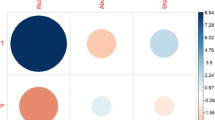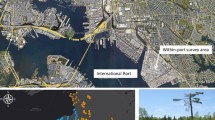Abstract
The Magellanic woodpecker (Campephilus magellanicus) is a vulnerable and poorly studied bird in the sub-antarctic deciduous and evergreen beech (Nothofagus) forests of South America. On Tierra del Fuego island (Chile), we compared Magellanic woodpecker abundance and its foraging habitat in two forest types: pure N. pumilio and mixed forests composed by N. pumilio and N. betuloides, including managed and non managed stands. At a regional scale, abundance of woodpeckers was greater in landscapes including both forest types than in pure N. pumilio landscapes. When both forest types occurred together, woodpecker abundance did not differ between them. The number of trees with foraging signs was correlated with Magellanic woodpecker abundance and was also associated with N. betuloides and snag densities, but was not affected by forest management. Occurrence of pecking on foraging trees was greater in mixed Nothofagus than pure N. pumilio stands. Woodpeckers foraged disproportionately more on larger diameter and more decayed trees. Moreover, trees used for foraging were positively correlated with canopy cover and snag density and were negatively correlated with distance to nearby peatlands and beaver ponds. Direct observation revealed that the flying distance between trees was negatively correlated with proportion of trees with foraging signs. Woodpeckers chose trees that were visited before, suggesting a pattern of tree recognition within foraging territories.




Similar content being viewed by others
References
Altmann J (1974) Observational study of behavior, sampling methods. Behavior 49:227–267
Angelstam P, Mikusinski G (1994) Woodpecker assemblages in natural and managed boreal and hemiboreal forest: a review. Ann Zool Fenn 31:157–172
Askins RA (1983) Foraging ecology of temperate-zone and tropical woodpeckers. Ecology 64:945–956
Bibby CJ, Burgess N, Hill D (1992) Bird census techniques. Academic Press, London.
Bonar RL (2000) Availability of pileated woodpecker cavities and use by other species. J Wildl Manage 64:52–59
Briones M, Schlatter R, Wolodarsky A, Venegas C (2001) Clasificación ambiental para hábitat de Castor canadensis (Kuhl 1820, Rodentia), de acuerdo a características de cuencas en un sector de Tierra del Fuego. An Inst Patagonia 29:75–93
Bull EL (1987) Ecology of the pileated woodpecker in north-eastern Oregon. J Wildl Manage 51:472–481
Bull EL, Holthausen RS (1993) Habitat use and management of pileated woodpeckers in northeastern Oregon. J Wildl Manage 57:335–345
Butorovic N (2001) Resumen meteorológico año 2000, estación Jorge C. Schythe. An Inst Patagonia 29:149–176
Conner RN, Rudolph DC, Saenz D, Coulson RN (1997) The red-cockaded woodpecker’s role in the southern pine ecosystem, population trends and relationships with southern pine beetles. Tex J Sci 49:139–154
Contreras IA, Gallardo CG, Kutschker A, Szulkin DS, Sihorsch M, Martinez L (2001) Hacia la conservación de las aves del lago Fontana, provincia de Chubut, Argentina. Abstr 1ª Reunión Binacional Ecol:261
Crawshay R (1907) The birds of Tierra del Fuego. Quaritch, London
Dodge KM, Whitmore RC, Harner EJ (1990) Analysis foraging use versus availability using regression techniques. Stud Avian Biol 13:318–324
Dolby AS, Grubb TC (1999) Effects of winter weather on horizontal and vertical use of isolated forest fragments by bark-foraging birds. Condor 101:408–412
Donoso C (1993) Bosques templados de Chile y Argentina. Editorial Universitaria, Santiago
Engstrom RT, Sanders FJ (1997) Red-cockaded woodpecker foraging ecology in an old-growth longleaf pine forest. Wilson Bull 109:203–217
Fall JB (1981) Mapping territories with playback: an accurate census method for songbirds. Stud Avian Biol 6:86–91
Ferrier G (1963) Aspectos ecológicos del Parque Nacional Nahuelbuta. Dissertation, Universidad de Chile, Santiago.
Fjeldsâ J, Krabbe N (1990) Birds of the high Andes. Zoological Museum, University of Copenhagen
Flemming SP, Holloway GL, Watts EL, Lawrance PS (1999) Characteristics of foraging trees selected by pileated woodpeckers in New Brunswick. J Wildl Manage 63:461–469
Franklin JF, Berg DR, Thornburg DA, Tappeiner JC (1996) Alternative silvicultural approaches to timber harvesting: variable retention harvest systems. In: Kohm KA, Franklin JF (eds) Creating a forestry for the 21st century: the science of ecosystem management. Island Press, D.C., pp 111–139
Goulding CJ, Lawrence ME (1992) Inventory practice for managed forest. Bulletin 171, Forest Research Institute, Rotorua, New Zealand
Gunn JS, Hagan J (2000) Woodpecker abundance and tree use in uneven-aged managed, and unmanaged, forest in northern Maine. For Ecol Manage 126:1-12
Hastriter MW (2001) Ceratophyllus altus Tipton and Mendez (Siphonaptera: Ceratophillidae) in Chile, with notes on the distribution of the genus Ceratophyllus Curtis 1823 in the southern hemisphere. Proc Entomol Soc Wash 103:582–585
Hejl SJ, Verner J Bell GW (1990) Sequential versus initial observations in studies of avian foraging. Stud Avian Biol 13:166–173
Humphrey PS, Bridge D, Reynolds PW, Peterson RT (1970) Preliminary Smithsonian Manual, Birds of Isla Grande (Tierra del Fuego). Smithsonian Institution, D.C.
Jones CM, Hunt HE (1996) Foraging habitat of the red-cockaded woodpecker on the D’Arbonne National Wildlife Refuge, Louisiana. J Field Ornithol 67:511–518
Lammertink M (1996) The lost empire of the ivory-billed woodpecker. World Birdwatch 18:8-11
Lammertink M, Estrada AR (1995) Status of the ivory-billed woodpecker Campephilus principalis in Cuba: almost certainly extinct. Bird Conserv Int 5:53–59.
McBride P (2000) Magellanic woodpecker (Campephilus magellanicus) habitat selection in deciduous Nothofagus forests of Tierra del Fuego. MS Thesis, Western Washington University, Bellingham, Wash.
Miranda B, Pasinelli G (2001) Habitat requirements of the lesser spotted woodpecker (Dendrocopos minor) in forest northeastern Switzerland. J Ornithol 142:295–305
Morrison ML (1984) Influence of sample size and sampling design on analysis of avian foraging behavior. Condor 86:46–150
Muller Y (1990) Ecological investigations of forest birds in the northern Vosges: a study of the breeding birds in successional stages of a beech forest. Gerfaut 80:73–106
Noon BR (1981) Techniques for sampling avian habitats. In Caspen E (ed) The use of multivariate statistics in studies of wildlife habitat. USDA, General Technical Report RM-87, pp. 42–51
Ojeda V (2003) Magellanic woodpecker frugivory and predation on a Lizard. Wilson Bull 115:208–210
Parker TA III (1991) On the use of tape recorders in avifaunal surveys. Auk 108:443–444
Pasinelli G, Hegelbach J (1997) Characteristics of trees preferred by foraging middle spotted woodpecker Dendrocopos medius in northern Switzerland. Ardea 85:203–209
Pisano E (1977) Fitogeografía de Fuego-patagonia Chilena I, comunidades vegetales entre las latitudes 52° y 56°S. An Inst Patagonia 8:121–250
Pisano E (1981) Bosquejo fitogeográfico de Fuego-patagonia. An Inst Patagonia 12:159–177
Rageot R, Gedda M (1978) Observaciones sobre el carpintero negro. Interim report. Departamento Técnico de Conservación del Medio Ambiente, CONAF, Temuco
Ralph CJ (1985) Habitat association patterns of forest and steppe birds of northern Patagonia, Argentina. Condor 87:471–483
Renken RB, Wiggers EP (1989) Forest characteristics related to pileated woodpecker territory size in Missouri. Condor 91:642–652
Reynolds PW (1934) Aspectos sobre aves de Tierra del Fuego. Hornero 5:339–353
Saavedra M (1996) Primer informe proyecto de conservación del carpintero grande ((Campephilus magellanicus (King 1828)) en las áreas silvestres protegidas de la IX Región. CONAF, Temuco, Chile
Saavedra M (1998) Avances en el proyecto de conservación del carpintero grande (Campephilus magellanicus, King 1828) en las áreas silvestres protegidas de la IX región de la Araucanía. In: Valverde V (ed) La conservación de la fauna nativa de Chile, logros y perspectivas. CONAF, Santiago, pp 107–119
Santana A (2000) Resumen meteorológico año 1999, estación Jorge C. Schythe. An Inst Patagonia 26:157–163
Savignac C, Desrochers A, Huot J (2000) Habitat use by pileated woodpeckers at two spatial scales in eastern Canada. Can J Zool 78:219–225
Schlatter RP, Vergara P (2001) Informe de monitoreo, proyecto Río Cóndor, sección aves. Instituto de Zoología, Universidad Austral de Chile, Valdivia, Chile
Schlatter RP, Venegas C, Bravo C, Torres-Mura JC (1995) Aves. Subproyecto 94–05. Estudio de Impacto Ambiental, Proyecto Río Cóndor, Tierra del Fuego. Forestal Trillium Ltda., Comisión Científica Proyecto Río Cóndor and Dames Moore. Vol.II, Santiago
Schmidt H, Caldentey J, Donoso S, Peña K (1996) Seguimiento forestal y ambiental del uso de los bosques de Lenga- XII Región. Informe, Universidad de Chile-CONAF, Chile
Setterington MA, Thompson ID, Montevecchi WA (2000) Woodpecker abundance and habitat use in mature balsam fir forests in Newfoundland. J Wildl Manage 64:335–345
Shackelford CE, Conner RN (1997) Woodpecker abundance and habitat use in three forest types in eastern Texas. Wilson Bull 109:614–629
Short LL (1970) Habits and relationships of the Magellanic woodpecker. Wilson Bull 82:115–123
Short LL (1982) Woodpeckers of the world. Delaware Museum of Natural History, Greenville, Md.
Short LL (1985) Neotropical and Afro-tropical barbets and woodpecker radiation: a comparison. Ornithol Monogr 36
Sokal RR, Rohlf FJ (1995) Biometry, 3rd edn. Freeman, New York
Stenberg I, Hogstad O (1992) Habitat use and density of breeding woodpeckers in the 1990’s in More og Romsdal County, Western Norway. Cinclus 15:49–61
Tuhkanen S, Kuokka I, Hyvönen S, Stenroos S, Niemelä J (1999) Tierra del Fuego as a target for biogeographical research in the past and present. An Inst Patagonia 19:4-107
Veblen TT, Schlegel FM, Oltremari, JV (1983) Temperate broad-leaved evergreen forests of South America. In: JD Ovington (ed) Temperate broad-leaved forests. Elsevier, Amsterdam, pp 5–31
Venegas C (1976) Observaciones ornitológicas en la tundra magallánica: recuento descriptivo del área y de las observaciones aviarias entre los paralelos 51°30′ y 52°09′S. An Inst Patagonia 7:171–184
Vuilleumier F (1985) Forest birds of Patagonia: ecological geography, speciation, endemism, and faunal history. Ornithol Monogr 36
Wigley TB, Sweeney SW, Sweeney JR (1999) Habitat attributes and reproduction of red-cockaded woodpeckers in intensively managed forests. Wildl Soc Bull 27:801–809
Winkler H, Christie D (2002): Family Picidae (woodpeckers). In: del Hoyo J, Elliott A, Sargatal J (eds) Handbook of the birds of the world. Lynx, Barcelona, pp 296–555
Winkler H, Christie D, Nurney D (1995) Woodpecker: a guide to woodpeckers of the world. Houghton Mifflin, New York
Zamora E, Santana A (1979) Características climáticas de la costa occidental de la Patagonia entre latitudes 46°40′S y 56°30′S. An Inst Patagonia 10:109–144
Zar JH (1998) Biostatistical analysis, 4th edn. Prentice-Hall, Englewood Cliffs, N.J.
Zwicker SM, Walters JF (1999) Selection of pines for foraging by red-cockaded woodpeckers. J Wildl Manage 63:843–852
Acknowledgements
This project was developed while participating on the Rio Cóndor Monitoring Program, Trillium Ltda. and then Savia Ltda., Punta Arenas. Special thanks are due to Edmundo Fahrenkrog (deceased) and Jose Garcinuño who permitted the use forest sites and facilities. Dieter Egger and Pascale from Switzerland, and Mireya Briones helped with data collecting and observations in the field. Permits for capturing and handling birds were obtained from the regional SAG (Servicio Agricola y Ganadero) office. We appreciate the improvements in English usage and statistical approach made by James Roper through the Association of Field Ornithologists’ program of editorial assistance. We dedicate this paper to Dr. Mary Kalin-Arroyo and Dr. Jerry Franklin for stimulus during the Monitoring program.
Author information
Authors and Affiliations
Corresponding author
Additional information
Communicated by F. Bairlein
Rights and permissions
About this article
Cite this article
Vergara, P., Schlatter, R.P. Magellanic woodpecker (Campephilus magellanicus) abundance and foraging in Tierra del Fuego, Chile. J Ornithol 145, 343–351 (2004). https://doi.org/10.1007/s10336-004-0052-7
Received:
Revised:
Accepted:
Published:
Issue Date:
DOI: https://doi.org/10.1007/s10336-004-0052-7




